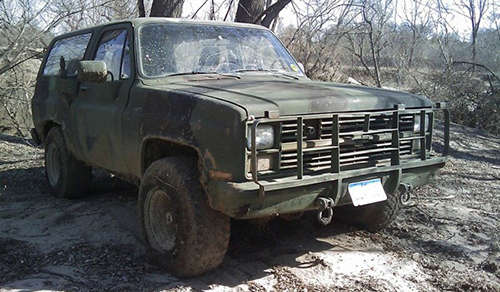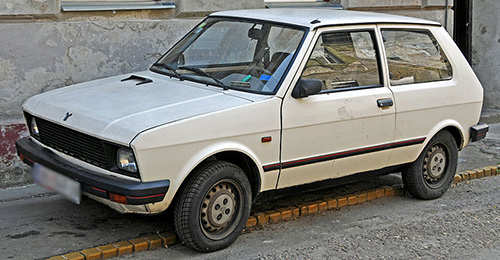
A lot of preppers are worried that, in the event, we’re ever attacked with EMP weapons, most of our vehicles will instantly turn to junk. This isn’t a far-out belief, either; it’s based on testing by the EMP Commission.
It’s true that those tests didn’t cause any permanent damage to the vehicles, but the Commission freely admits that they stopped testing at the level of EMP where the vehicles stopped running – and that was far below the levels that would be emitted by an actual attack.
It’s difficult to predict what damage an EMP attack would do to vehicles because so many variables are involved. We can make some educated guesses, though. We do know that EMP can destroy solid-state electronics, and late-model vehicles depend on those for almost everything. Without its engine management computer, a modern car won’t even start.
If your new truck is caught by an EMP the chances are it’s going to take a lot of work to get it running again. You’re almost certainly going to have to replace all the computers if you can find undamaged spares, and EMP can do funny things to wiring as well.
As the wiring harness is one of the first things installed in cars, replacing it is a huge job. Is it going to be feasible in a country devastated by the attack? I’m not betting on it.
There is another option, though – find yourself a vehicle that doesn’t rely on electronics. Computer-controlled car engines didn’t really exist until the mid-1970s and there were plenty of new cars without them at the end of the decade, so most vehicles that age or older will be much more resistant to EMP. Carbureted engines with simpler wiring looms don’t give the pulse much to get their teeth into.
The bad news is that we’re talking about some pretty old, and often hard-used, vehicles here. The good news is that in many cases you should be able to get a running one for a reasonable amount of money. Here are six EMP-proof vehicles you can pick up for less than $2,000.
Volkswagen Beetle

You can easily pay over $100,000 for a classic Bug in immaculate condition – but you can also get a runner for under $2,000. In fact, while I was writing this I saw one for $500 that just needs some work on the hubs to put it back on the road. The post-1971 “Super Beetle” is usually cheaper than the classic flat windshield model.
The Beetle is built on really old technology. It has a flat-four air-cooled engine without any hint of electronics.
It’s also a rugged and reliable car that’s good enough off-road that the German army put an open-topped body on it and used it as a jeep. It won’t even notice an EMP.
Dune Buggies

VW Bugs are classic cars now, but from the 60s through the early 80s they were just cheap imports – and a lot of people used their simple mechanicals as the basis for a dune buggy. Usually, this involved shortening the Beetle chassis by about a foot and fitting it with a simple, lightweight fiberglass body.
Dune buggies have decent fuel economy and off-road performance, and they don’t rust. They’re also very easy to modify into survival vehicles, and they don’t need a lot of maintenance. You can find a running one for about $800 upwards.
CUCV (Commercial Utility Cargo Vehicle)

In the mid-1970s the US military was running out of utility vehicles. The HMMWV program hadn’t produced anything yet and the old M151 jeeps were wearing out. As a stopgap, thousands of commercial wagons and trucks were purchased, in slightly militarized versions.
There are a few different models of CUCV, but the most common is the M1109 – a 1984-model Chevrolet K5 Blazer. This is a simple vehicle with plenty of load space, 4wd, and a powerful 6.2-liter diesel engine, and it’s ideal as a post-SHTF vehicle. Thousands have been disposed of at auctions and you can easily find a usable one for under $2,000. Try eBay.
International Harvester Scout

The Scout was probably the first mass-produced SUV, even if it was never the most exciting or popular. It’s a simple, sturdy, and reliable vehicle, though, and it has great off-road performance.
The original Scout is starting to get expensive, so look for a Scout II. Manufactured from 1971 to 1980, this is a lot cheaper and just as reliable. You can find rough but repairable ones for under $1,000; $2,000 will get you a good runner.
Chevrolet Cheyenne

Chevrolet produced this full-size truck from 1959 through to the turn of the century, but what you’re looking for is a pre-1980 third-generation model. With a computer-free engine and easily maintained mechanicals, it’s a tough and practical utility vehicle.
A lot of these are still hanging on in rural areas, and you can pick up a running example for under $1,500 if you hunt around. Can’t find a Cheyenne? No problem; most other pre-1980 trucks will do just as well.
Yugo

No, don’t laugh. This cheap and nasty car was imported into the USA from 1985 to 1991 – but mechanically it’s a 1970s Fiat 127, so its 900cc engine is EMP-proof. Incredibly, good examples now sell for up to $15,000 – but you can get an average one for under $1,000 because nobody wants them.
The thing is, this is a cheap communist-built car with a tacky finish and unreliable accessories, but the engine is simple and reliable. It might be an embarrassing car to drive, but it’s a lot less embarrassing than one that won’t start because its electronics are fried.
Other self-sufficiency and preparedness solutions recommended for you:
The vital self-sufficiency lessons our great grand-fathers left us
Knowledge to survive any medical crisis situation
The Smart, Easy Way to Food Independence
Your secret weapon when our society shatters into a million pieces
Secure your privacy in just 10 simple steps
























MP / January 12, 2019
Funny thing is they included a few cars that’ll be a little harder to find as of now but excluded some that would be more likely to be available for cheap. Any older ford from the early 70s back (mustang, falcon, maverick, etc, especially base models would fit. Really any car from the early 80s back would work, you can get the older components (points distributor, etc to *deconvert* the system to one like the older units. GM B, F, and G bodies from the 80s are cheap and can be modified as mentioned. Other similar 80s cars fall into this category too.
/
CK / January 12, 2019
As a long-time International driver, I can say that Scouts are indeed a very tough and able machine. They do not drive like modern vehicles, and a poor driver is going to get them stuck. If you DO learn how to work them, a Scout can be amazing. Bad mileage, slow to start in the cold, and very heavy, yet with a good new style bumper they can smash through heavy brush and small trees. Just learn them well.
/
Al / January 17, 2019
Good luck finding a fiberglass dunebuggy for $2K!!!
You MAY luck out and find a good VW for under $2k, but my money says, “You won’t”.
ANY pickup under $2K is going to be an absolute pos. The mentioned early 6.2 diesels were a disaster. I think 1 out of 100 people had good luck with them.
With all the vehicles out there that could probably be bought for $2k or less, the author sure picked some ‘least likely to suceed’.
/
Al / January 17, 2019
About 4 years ago, I traded a Yugo in decent condition for a bottle of Jack Daniels. I still lose sleep at night thinking about how I took unfair advantage of that young lady. A lot of Jack since then is helping me get over it.
/
Reggie Arford / January 17, 2019
Very interesting, and useful, but: What fuel are these going to run on? I doubt any modern gas station equipment will be usable after an EMP, especially after the power is knocked out. Even if you could suck it out of the station’s tank, that will only last so long.
/
Bruce Meyer / January 18, 2019
There will be a LOT of stalled unusable vehicles with plenty of gas in the tanks. Admittedly, the gas will go bad over time. Maybe stock up on some ‘Stabil? 🙂 Have a hand operated Siphon so you can get the fuel out, or in a pinch, poke a hole in the tank and drain into a bucket. You’ll waste a lot of fuel that way, and won’t be able to ‘revisit’ that vehicle to get the rest of the fuel later. So, get a siphon, and make sure the hose fits in the hole. Oh, be sure to own a high capacity fuel can or three for your foraging trips.
/
Mark M / January 17, 2019
I would think a ‘65 or ‘66 Corvair with a 180hp engine might be a good option
/
Adam Strout / February 23, 2019
Excellent article. The author wasn’t trying to say these are the only vehicles that could be obtained. In fact, he said that any vehicle pre 1980 would likely work. The intent of this article is to get you thinking and it did that very well. Thank you. Keep conversations like this coming as they are great. Bruce’s comment on having several gas cans and a siphon/pump is an excellent point too. That stuff will be gone in a EMP/SHTF event.
/
Bo W / February 23, 2019
What about installing a “Cut-off Switch”? Will that work if you use it?
I have one connected on my 98 Ford Explorer and I’m hoping that should we be hit by an EMP that I should be able to get my truck started up once I turn the Cut-Off Switch back to Power… Will this work or am I just having Wishful thoughts??
/
Randy / March 2, 2019
How come the Older Jeeps are not included??
/
RKP / March 16, 2019
Anyone know whether 1976 Trans Am Firebirds and Camaros would would still run,?
/
Vonu / March 24, 2019
Since there has never been a real documented EMP attack in the history of the planet, until evidence appears that the “scientific” estimates are any more realistic than Harry Potter, I’ll be waiting for something other than fantasy. Anything that can damage a wiring harness can destroy any kind of automotive technology since the magneto.
/